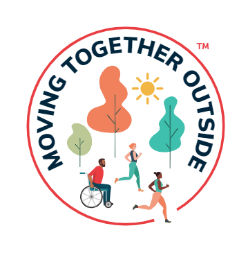On September 23, the Moving Together Outside campaign presented an introspective Facebook live session.
Dr. Amy Bantham, the national spokesperson for the Moving Together Outside campaign, hosted the 50-minute panel along with three other subject matter experts:
- Megan Gamble—Co-Founder of POWER FitCamp, outdoor boot camp fitness company
- Graham Melstrand—Executive Vice President of Mission and Innovation at ACE
- Sameera Rao—Project Manager for the City of San Diego’s Spaces as Places Program
The thoughtful session discussed how the goals and objectives of the Moving Together Outside campaign are being lived out in communities across the nation. Read on to take a peek at some of the session’s topical highlights.

What is the value of shared-use agreements (SUAs) in our communities?
Shared-use agreements (SUAs) are a win/win/win for community residents, exercise professionals, and local governments. Here’s how:
- For community residents: Before the pandemic, public parks across the country were underutilized. “Now, because of the increase in SUAs, every single day parks are vibrant, active places bolstering the health of community residents,” Graham said.
- For exercise professionals. “SUAs can truly facilitate and create a more equitable, inclusive, safe climate for fitness professionals to host their group exercise programs,” Megan said. “They also build productive relationships between exercise professionals and local Parks and Recreation departments.”
- For local governments: “Any public space that can be used in a variety of ways by diverse groups of people is wonderful,” Sameera said. “Public spaces are not meant to be used for just a few hours, here and there. Creating optimal use of our public spaces is the goal.”
How can exercise professionals get started with securing an SUA?
The process of securing an SUA for your group exercise class could be as simple as submitting an application with your local government. Follow these steps to begin the process:
- Do your research: Start by visiting your city’s Parks and Recreation Department website, as this is typically the organization that issues SUAs.
- Connect directly with park rangers: Megan shared that talking with onsite park rangers in her city was extremely helpful in directing her to the specific people in charge of issuing SUAs.
- Visit park community centers: Many larger parks have onsite community centers with staff who can assist, as well.
- Have everything ready: When you apply for your SUA permit, be sure to have all of your documents and certifications in order—especially proof of professional liability insurance.
- Who do you want to be your client? Consider the demographics of your target clients, and decide which locations would best serve them and their needs.
- What experiences do you want to provide? Choose locations with facilities, terrain, or open spaces that align well with the types of group exercise classes you’re offering.
- Consider partnering with community programs: Some cities have rolled out physical activity initiatives that partner with a variety of local organizations and certified exercise professionals to bring free structured exercise programs to the community at large. Check and see if your city has such a program.
How has pivoting to outdoor fitness helped exercise professionals across the board?
- Created entrepreneurial opportunity: Outdoor group fitness classes do not require the same capital investment as indoor, brick-and-mortar businesses. “That has created the opportunity and impetus for more exercise professionals to now formally establish and grow their businesses,” Graham said.
- Allowed for diverse programming: “Being outdoors allows for the types of physical activity that clients may not want to do indoors, or that don’t lend themselves to being delivered very well indoors,” Megan said.
- Acted as a way to fulfill “park prescriptions”: Many health and social service providers now write “park prescriptions” for clients who are at risk for chronic disease. These prescriptions encourage them to spend time in nature to improve their health and well-being. “This intersection of clinical and community is critical because, with structured outdoor exercise offerings, these folks get the support and structure they need to actually ‘fill their prescription’ and be active,” Graham said.
In what ways does the promotion of exercise programs in public spaces help create community?
- Breeds social interaction: “When going to the park for group fitness classes camps, it becomes all about interacting with others and feeling part of the community,” Megan said. “You’re making real friends, and that social part is at the core of building community.”
- Makes physical activity exciting: “My crowd really loves their outdoor workouts,” Megan said. “It has a whole different vibe. Honestly, outdoor workouts are more fun and exciting for them. It’s something they want to continue to do, even post-pandemic.”
- Prioritizes fun above obligation: What better way to make physical activity palatable than making it less about weight loss and discipline, and more about fun, social settings, and groups coming together for a common goal?
- Creates community ownership: “When people become active in public spaces, it creates a sense of community ownership,” Sameera said. “This is true for all ages and abilities.”
What tips would you give to local governments that are considering issuing more SUAs?
- Awareness is key: “First, local governments need to have a strong awareness and understanding of, what are the different things that they can truly do with a space?” Sameera said.
- Make creative use of spaces: Not all neighborhoods have existing parks or places where people can easily engage in physical activity. In these cases, governments need to get creative. “For example, cities can build promenades that close off a section of a street, which could then be used for community activities like children’s play, dancing, or games,” Sameera said.
- Focus on happiness: “Create new, happy experiences and happy places across your city,” Sameera said. “Be sure SUAs serve everyone and are not restricted to certain neighborhoods and areas. Adapt from the culture of each specific community.”
If you are interested in becoming a supporter of the Moving Together Outside campaign and learning more, please visit our website.




 by
by 




